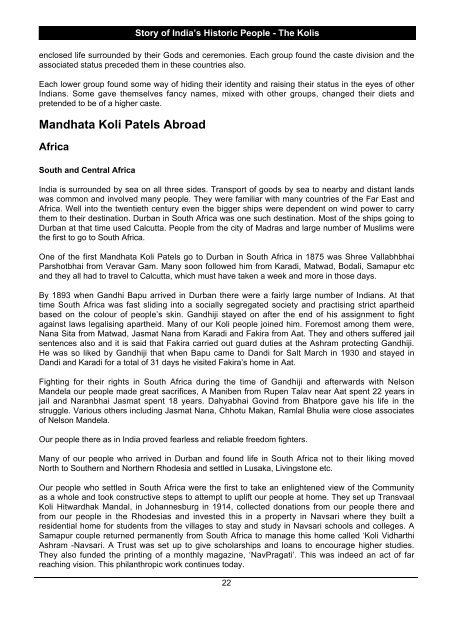THE ASSOCIATION OF MANDHATA SAMAJ UK - Mandhata Global
THE ASSOCIATION OF MANDHATA SAMAJ UK - Mandhata Global
THE ASSOCIATION OF MANDHATA SAMAJ UK - Mandhata Global
You also want an ePaper? Increase the reach of your titles
YUMPU automatically turns print PDFs into web optimized ePapers that Google loves.
Story of India’s Historic People - The Kolis<br />
enclosed life surrounded by their Gods and ceremonies. Each group found the caste division and the<br />
associated status preceded them in these countries also.<br />
Each lower group found some way of hiding their identity and raising their status in the eyes of other<br />
Indians. Some gave themselves fancy names, mixed with other groups, changed their diets and<br />
pretended to be of a higher caste.<br />
<strong>Mandhata</strong> Koli Patels Abroad<br />
Africa<br />
South and Central Africa<br />
India is surrounded by sea on all three sides. Transport of goods by sea to nearby and distant lands<br />
was common and involved many people. They were familiar with many countries of the Far East and<br />
Africa. Well into the twentieth century even the bigger ships were dependent on wind power to carry<br />
them to their destination. Durban in South Africa was one such destination. Most of the ships going to<br />
Durban at that time used Calcutta. People from the city of Madras and large number of Muslims were<br />
the first to go to South Africa.<br />
One of the first <strong>Mandhata</strong> Koli Patels go to Durban in South Africa in 1875 was Shree Vallabhbhai<br />
Parshotbhai from Veravar Gam. Many soon followed him from Karadi, Matwad, Bodali, Samapur etc<br />
and they all had to travel to Calcutta, which must have taken a week and more in those days.<br />
By 1893 when Gandhi Bapu arrived in Durban there were a fairly large number of Indians. At that<br />
time South Africa was fast sliding into a socially segregated society and practising strict apartheid<br />
based on the colour of people’s skin. Gandhiji stayed on after the end of his assignment to fight<br />
against laws legalising apartheid. Many of our Koli people joined him. Foremost among them were,<br />
Nana Sita from Matwad, Jasmat Nana from Karadi and Fakira from Aat. They and others suffered jail<br />
sentences also and it is said that Fakira carried out guard duties at the Ashram protecting Gandhiji.<br />
He was so liked by Gandhiji that when Bapu came to Dandi for Salt March in 1930 and stayed in<br />
Dandi and Karadi for a total of 31 days he visited Fakira’s home in Aat.<br />
Fighting for their rights in South Africa during the time of Gandhiji and afterwards with Nelson<br />
Mandela our people made great sacrifices, A Maniben from Rupen Talav near Aat spent 22 years in<br />
jail and Naranbhai Jasmat spent 18 years. Dahyabhai Govind from Bhatpore gave his life in the<br />
struggle. Various others including Jasmat Nana, Chhotu Makan, Ramlal Bhulia were close associates<br />
of Nelson Mandela.<br />
Our people there as in India proved fearless and reliable freedom fighters.<br />
Many of our people who arrived in Durban and found life in South Africa not to their liking moved<br />
North to Southern and Northern Rhodesia and settled in Lusaka, Livingstone etc.<br />
Our people who settled in South Africa were the first to take an enlightened view of the Community<br />
as a whole and took constructive steps to attempt to uplift our people at home. They set up Transvaal<br />
Koli Hitwardhak Mandal, in Johannesburg in 1914, collected donations from our people there and<br />
from our people in the Rhodesias and invested this in a property in Navsari where they built a<br />
residential home for students from the villages to stay and study in Navsari schools and colleges. A<br />
Samapur couple returned permanently from South Africa to manage this home called ‘Koli Vidharthi<br />
Ashram -Navsari. A Trust was set up to give scholarships and loans to encourage higher studies.<br />
They also funded the printing of a monthly magazine, ‘NavPragati’. This was indeed an act of far<br />
reaching vision. This philanthropic work continues today.<br />
22

















